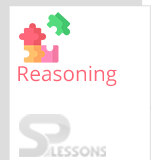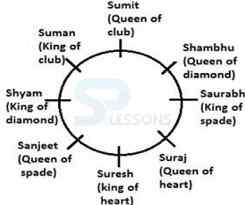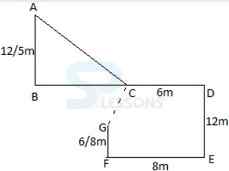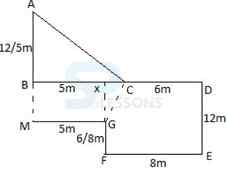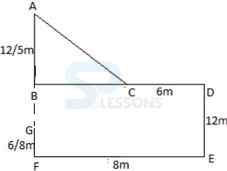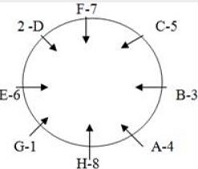 Introduction
Introduction
IBPS Clerk 2019 – Preliminary Examination, conducted in online Mode, has: a duration of 1 hour, a total of 100 questions, a maximum score of 100 marks, and, consists of 3 sections, namely – English Language, Numerical Ability and Reasoning Ability. The 3 sections are separately timed and the questions can be attempted in any order. IBPS Clerk 2019 Prelims exam is scheduled on 07.12.2019, 08.12.2019, 14.12.2019 & 15.12.2019 and Mains Exam is scheduled on 19.01.2020.
 Pattern
Pattern
| S.No | Name Of Test | No.of Questions | Maximum Marks | Duration |
|---|---|---|---|---|
| 1 | English | 30 | 30 | 20 minutes |
| 2 | Numerical Ability | 35 | 35 | 20 minutes |
| 3 | Reasoning Ability | 35 | 35 | 20 minutes |
| Total | 100 | 100 | 60 minutes |
 Syllabus
Syllabus
| Topic | Number of Questions |
|---|---|
| Inequalities | 0-5 |
| Syllogism | 0-5 |
| Coding | 0-5 |
| Puzzles | 5-10 |
| Seating Arrangement | 0-5 |
| Blood Relaitons | 0-1 |
| Ranking | 1-2 |
| Direction Sense | 1-2 |
Note: Penalty for Wrong Answers
There will be penalty for wrong answers marked in the Objective Tests. For each question for which a wrong answer has been given by the candidate one fourth or 0.25 of the marks assigned to that question will be deducted as penalty to arrive at corrected score. If a question is left blank, i.e. no answer is marked by the candidate, there will be no penalty for that question.
 Quiz
Quiz
Direction[1-5]: Study the following information carefully and answer the questions given below it.
There are eight friends Sanjeet, Sumit, Suman, Suraj, Suresh, Saurabh, Shambhu and Shyam sitting around a circular table facing the centre and playing cards but not necessarily in the same order. All of them have a favourite card among these eight cards. Out of these eight cards, four are Kings and four are Queens of spade, club, diamond and heart.
Sanjeet likes the Queen of spade and is not an immediate neighbour of the one who likes the King of club. The one who likes the Queen of diamond sits on the immediate left of Sumit, who likes the Queen of club. Suman likes the King of club and sits third to the left of Suresh. The one who likes the King of spade and the one who likes the Queen of diamond are immediate neighbours of each other but both of them are the neighbours neither of Suresh nor of Suman. The one who likes the King of diamond and the one who likes the Queen of spade are immediate neighbours of each other. Neither Suresh nor Suraj likes the King of diamond. Only Saurabh sits between the one who likes the Queen of diamond and the one who likes the Queen of heart. Shambhu sits third to the left of the person who likes the King of diamond.
1. Who likes the King of spade?
- A. Saurabh
B. Shambhu
C. Shyam
D. Cannot be determined
E. None of these
- A. Queen of spade
B. King of heart
C. Queen of heart
D. Cannot be determined
E. None of these
- A. Queen of club
B. King of diamond
C. King of club
D. King of spade
E. None of these
- A. A None
B. One
C. Two
D. Three
E. None of these
- A. Sumit, Suman
B. Sanjeet, Sumit
C. Suresh, Sanjeet
D. Suraj, Shambhu
E. None of these
Direction[1-3]: Read the following information carefully to give the answers to the questions based on it.
P # Q means P is to the south of Q;
P @ Q means P is to the north of Q;
P % Q means P is to the west of Q;
P $ Q means P is to the east of Q;
P ! Q means P is either at 5 or 12 meters from Q;
P & Q means P is either at 6 or 8 meters from Q.
Note:
1) P @ & Q means P is north of Q at a distance of either 6 or 8 meters.
2) P # % Q means P is to the south-west of Q.
Conditions:
I. A @ ! B
II. A @ % C
III. C $ B
IV. C % & D
V. E # ! D
VI. F % & E
VII. G @ & F
VIII. G # % C
1. Given M % G, MG = 5 meters, B @ M. Find the distance between B and C?
- A. 6 meters
B. 12 meters
C. 7 meters
D. 8 meters
E. None of these
- A. G @ ! B
B. B @ ! G
C. B # & G
D. G # & B
E. None of these
- A. Root 45
B. Root 74
C. Root 79
D. Root 83
E. None of these
- A. If only Conclusion I is true.
B. If only Conclusion II is true.
C. If either Conclusion I or II is true.
D. If neither Conclusion I nor II is true.
E. If both Conclusions I and II are true.
- A. If only Conclusion I is true.
B. If only Conclusion II is true.
C. If either Conclusion I or II is true.
D. If neither Conclusion I nor II is true.
E. If both Conclusions I and II are true.
Direction[1-5]: Study the following information carefully and answer the questions given below it.
A, B, C, D, E, F, G and H study in different standards viz. 1st, 2nd, 3rd, 4th, 5th, 6th, 7th and 8th. All of them are seated around a circular table facing the centre. C sits third to the right of H. H studies in std. 8. F sits second to the left of E. E is not an immediate neighbor of C or H. The one who studies in std. 1 is an immediate neighbor of E. Three people sit between H and the student of std. 7.H, C and also their immediate neighbours do not study in std. 2. Only one person sits between, the student of std. 2 and G. Students of std. 3 and 4 are immediate neighbours of each other. C is neither in std. 4 nor in std. 3. Only one person sits between A and the student of std 5. A does not study in std. 2 or 3. B does not study in std. 2.
1. Which of the following is true regarding F?
- A. F studies in std. 5
B. D and G are immediate neighbours of F
C. One person sits between F and the student of std. 4
D. F sits second to right of A
E. None of true
- A. C
B. F
C. G
D. B
E. Cannot be determined
- A. None
B. One
C. Two
D. Three
E. Four
- A. Only one person is sitting between student of std. 4 and std. 6
B. D studies in std. 2
C. The one studying in std. 3 is an immediate neighbour of H
D. One person sits between H and the student of std. 2
E. None is true
- A. A, B
B. E and the student of std. 2
C. H and the student of std. 6
D. E, F
E. A, D
